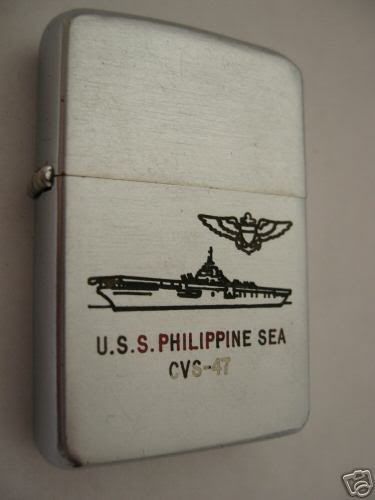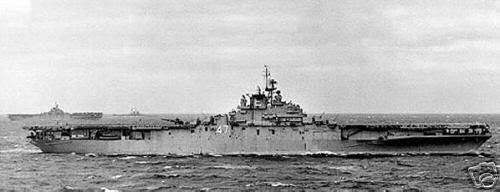[im

g][/im

g]USS PHILIPPINE SEA was the last ESSEX - class aircraft carrier and the first ship in the Navy to bear the name. Decommissioned on December 28, 1958, and berthed with the Reserve Fleet at Long Beach, she was redesignated as AVT 11 on May 15, 1959. PHILIPPINE SEA was struck from the Navy List December 1, 1969, and sold for scrapping in March 1971.
General Characteristics: Awarded: 1943
Keel laid: August 19, 1944
Launched: September 5, 1945
Commissioned: May 11, 1946
Decommissioned: December 28, 1958
Builder: Bethlehem Steel Co., Quincy, Mass.
Propulsion system: 8 boilers
Propellers: four
Aircraft elevators: three
Arresting gear cables: four
Catapults: two
Length: 888.5 feet (270.8 meters)
Flight Deck Width: 129.9 feet (39.6 meters)
Beam: 101 feet (30.8 meters)
Draft: 30.8 feet (9.4 meters)
Displacement: approx. 38,500 tons full load
Speed: 33 knots
Planes: 80-100 planes
Crew: approx. 3448 as CVS: 1000
Armament: see down below
History of USS PHILIPPINE SEA:
USS PHILIPPINE SEA was laid down by the Bethlehem Steel Co., Quincy, Mass. 19 August 1944, launched 5 September 1945 sponsored by Mrs. Albert B. Chandler; and commissioned 11 May 1946, Capt. D.S. Cornwell in command. In June, the ship went to Quonset Point, R.I., for initial training of the crew. By September 1946, she began her shakedown cruise in the Caribbean area with Air Group 20 embarked.
Upon returning from shakedown exercises, PHILIPPINE SEA was ordered back to Boston to prepare for the Navy's Antarctic Expedition, Operation Highjump. On 29 January 1947, from a position 660 miles off the Antarctic continent, PHILIPPINE SEA launched the first of six R4D transport aircraft which she had ferried from Norfolk, Va., as part of Operation Highjump. The first plane off, which was also the first carrier takeoff for an R4D, was piloted by Cmdr. William M. Hawkes and carried Rear Adm. Richard E. Byrd and his party from the ship to begin their polar explorations from Little America.
During the remainder of 1947, PHILIPPINE SEA operated in the Atlantic and Caribbean. In the spring of 1948, the ship was deployed to the Mediterranean to join Vice Adm. Forrest Sherman's 6th Fleet. With Air Group 9 on board, PHILIPPINE SEA showed the American ensign in France, Greece, Tunisia and Sicily. In June 1948, the huge carrier returned to the United States.
During the summer, PHILIPPINE SEA was engaged in developing doctrine for carrier control approach landings, the sea going equivalent of ground control approach. November 1948 found her exploring the lower rim of the Arctic Circle in a cold weather operation designed to test planes, ships, and equipment.
In January 1949 the ship was again ordered to the Mediterranean, with Air Group 7 embarked. Returning at the end of May, the ship went immediately into overhaul at the Boston Naval Shipyard. Early autumn found the ship once more in the Caribbean, "shaking down," this time with Air Group 1. Operational development projects with jet fighters and task force exercises in the North Atlantic kept the ship and her air group busy until the end of the year.
Operating again from her base at Quonset Point, PHILIPPINE SEA was employed during the winter of 1950 in qualifying carrier pilots and, for part of February and most of March, took part in extensive fleet exercises in the Atlantic and Caribbean. April and May were taken up with demonstration cruises for guests of the Secretary of the Navy, the Armed Forces Industrial College, Air War College, and the Armed Forces Staff College.
On 24 May 1950, PHILIPPINE SEA sailed from Norfolk, Va., passed through the Panama Canal, and arrived at her new homeport of San Diego, Calif., to become a welcome addition to the Pacific Fleet.
With the outbreak of war in Korea, PHILIPPINE SEA was ordered to Pearl Harbor. She sailed for Hawaiian waters on 5 July 1950 with Air Group 11 embarked. The ship departed for the forward area 24 July. Leaving Pearl Harbor, PHILIPPINE SEA sailed at full speed for the western Pacific, reaching Okinawa, 1 August. Responding to an urgent request by Lt. Gen. Walton H. Walker, commanding general of the U.S. Eighth Army, the carriers of Task Force 77 began the unaccustomed task of providing tactical air support for Army forces holding the hard-pressed Pusan perimeter. PHILIPPINE SEA, which joined the combat operations on 5 August, along with the escort carrier USS BADOENG STRAIT (CVE 116) were the first carrier reinforcements to arrive in the Far East and the beginning of carrier deployments to the combat area that, by the conflict's end, totalled 11 attack, one light, and five escort carriers being sent into action - some for two or three tours.
PHILIPPINE SEA sailed into action off Korea as flagship of Task Force 77 on 5 August 1950. She launched air strikes to rain thousands of tons of bombs, rockets, and napalm down on strategic targets. As many as 140 sorties a day were launched from the carrier. Except for time out to re-arm, refuel, or repair for brief periods, PHILIPPINE SEA was in action continuously for almost three years.
Operating with other carriers of Task Force 77, she hit North Korean rail and communication centers from Seoul to Wonsan in September. In the Yellow Sea she put on a major performance softening up the Inchon invasion coast. D-Day, 15 September 1950, found PHILIPPINE SEA planes ranging far inland to destroy any attempts by the enemy to bring up reinforcements. Following the initial assault, she continued to provide close and deep support for the thrust inland to Seoul.
On 9 November 1950, Lt. Cmdr. W.T. Amen, flying an F9F-2 Panther from PHILIPPINE SEA, downed a MiG-15 to become the first Navy pilot to destroy an enemy jet fighter.
Eight Chinese Communist regular troops, part of approximately 300,000 Chinese which entered North Korea largely undetected by U.N. forces, attack 1st Marine Division positions to the west and south of the Chosin Reservoir on 27 November. The Marines hold their ground but the Chinese cut the road between the Marines' main body at Yudam-Ni, division headquarters 14 miles to the south at Hagaru-Ri, and from there south. Two days later, the X Corps commander, Army Maj. Gen. Edward Almond, orders the 1st Marine Division to fall back to Hamhung. PHILIPPINE SEA planes dived through snow and sleet to hold back the Chinese. Throughout the long retreat from the Yalu, the ships' Panther jets, Skyraider attack bombers and Corsair fighter bombers blasted the path for the trapped Marines. Hill after hill was cleared all the way to Hungnam where PHILIPPINE SEA and other carriers of Task Force 77 sent up a virtual aerial umbrella. From 10 through 24 December, hundreds of carrier planes swarmed over the tiny evacuation perimeter around the port of Hungnam from which 150,000 troops and civilians came to the sea.
Putting into Yokosuka Naval Base, Japan, 26 March 1951 for rest and repair, PHILIPPINE SEA exchanged Air Group 11 for Air Group 2 (CVG 2) from USS VALLEY FORGE (CV 45). The same date as the transfer, 28 March 1951, PHILIPPINE SEA became flagship of Vice Adm. H. M. Martin, Commander 7th Fleet and the ship immediately departed with CVG 2 for another tour in Korea.
From the Sea of Japan in April 1951, PHILIPPINE SEA led Task Force 77 and other elements of the 7th Fleet down through the Strait of Formosa to the South China Sea. From the Formosa Strait, planes paraded over the island of Formosa in an attempt to bolster Nationalist morale. After this demonstration of strength, the force steamed back to Korea three days later, in time to lend close air support to the embattled ground forces. Every Chinese offensive of the spring of 1951 suffered staggering losses in personnel as planes of PHILIPPINE SEA peppered the Reds with deadly fragmentation bombs.
PHILIPPINE SEA returned from her operations in Korean waters and the western Pacific to arrive at San Francisco, 9 June 1951. Yard availability and operations along the West Coast continued until the ship departed from San Diego, 31 December. On 19 December 1951, PHILIPPINE SEA was the site of a test of emergency assembly capabilities for nuclear weapons. This marked the initial and successful introduction of special weapons into the Pacific fleet. Arriving at Pearl Harbor 8 January 1952, PHILIPPINE SEA continued on to Yokosuka, Japan, arriving 20 January.
Again on the line for her third tour in Korea, PHILIPPINE SEA remained in action until relieved in late July 1952. On 23 June, 35 AD Skyraiders and 35 F9F-2 Panther jets from USS BOXER (CV 21), USS PRINCETON (CV 37) and PHILIPPINE SEA joined Air Force Thunderjets in an attack on the heavily defended hydroelectric power plant at Suiho, North Korea, the fourth largest such facility in the world. The plant was completely knocked out. The raid was part of a two-day aerial offensive against North Korea's 13 major power plants.
PHILIPPINE SEA returned to San Diego 8 August 1952. Her designation was changed to CVA in October. With Carrier Air Group 9 embarked, she got underway once more for the Far East on 15 December 1952. Air strikes from the carrier cut Communist supply and transportation arteries. The North Korean offensive, begun at the same time the first truce overtures were extended, marked the beginning of a series of "round the clock" air sorties in support of frontline UN troops.
The ship returned to Alameda Naval Air Station 14 August 1953 to off-load Air Group 9, then entered drydock at Hunter's Point for overhaul. On 9 January 1954, PHILIPPINE SEA once more began training off the coast of San Diego. She then headed west, 12 March, for her fourth tour in the Far East. She operated out of Manila.
The most significant event of the cruise occurred 26 July 1954. Communist planes had shot down a Cathay-Pacific Airways passenger liner somewhere near Hainan Island off the Chinese coast 23 July. PHILIPPINE SEA was ordered into the area as part of a search mission with the hope that the remaining survivors might be found. While engaged in the search mission, two of the ship's AD Skyraider aircraft were attacked by two Communist fighter aircraft. Under orders to fire only if actually attacked, the Skyraiders returned the fire and shot down the Communist planes. Later this came to be known unofficially as the "Hainan Incident."
The ship returned to San Diego, Calif., in November 1954. Remaining in the area for four months, PHILIPPINE SEA conducted extensive training operations off the California coast. She began her fifth cruise of the Far East 1 April 1955 enroute Yokosuka . She operated in waters of Japan, Okinawa, and Taiwan. On 15 November, she was redesignated as a CVS. She returned to San Diego, 23 November 1955.
Leave, upkeep, and operations off the southern California coast and in Hawaiian waters followed and in March 1957 she got underway for another WestPac tour. There for only a little over two months, she returned to San Diego and resumed local operations off the west coast in mid-summer. In January 1958, she steamed west on her last 7th Fleet deployment.
Remaining six months, PHILIPPINE SEA returned to San Diego 15 July 1958 and commenced inactivation. Decommissioned 28 December 1958 and berthed with the Reserve Fleet at Long Beach, she was redesignated AVT 11, 15 May 1959. PHILIPPINE SEA was struck from the Navy List 1 December 1969 and sold for scrapping in March 1971.
--------------------------------------------------------------------------------